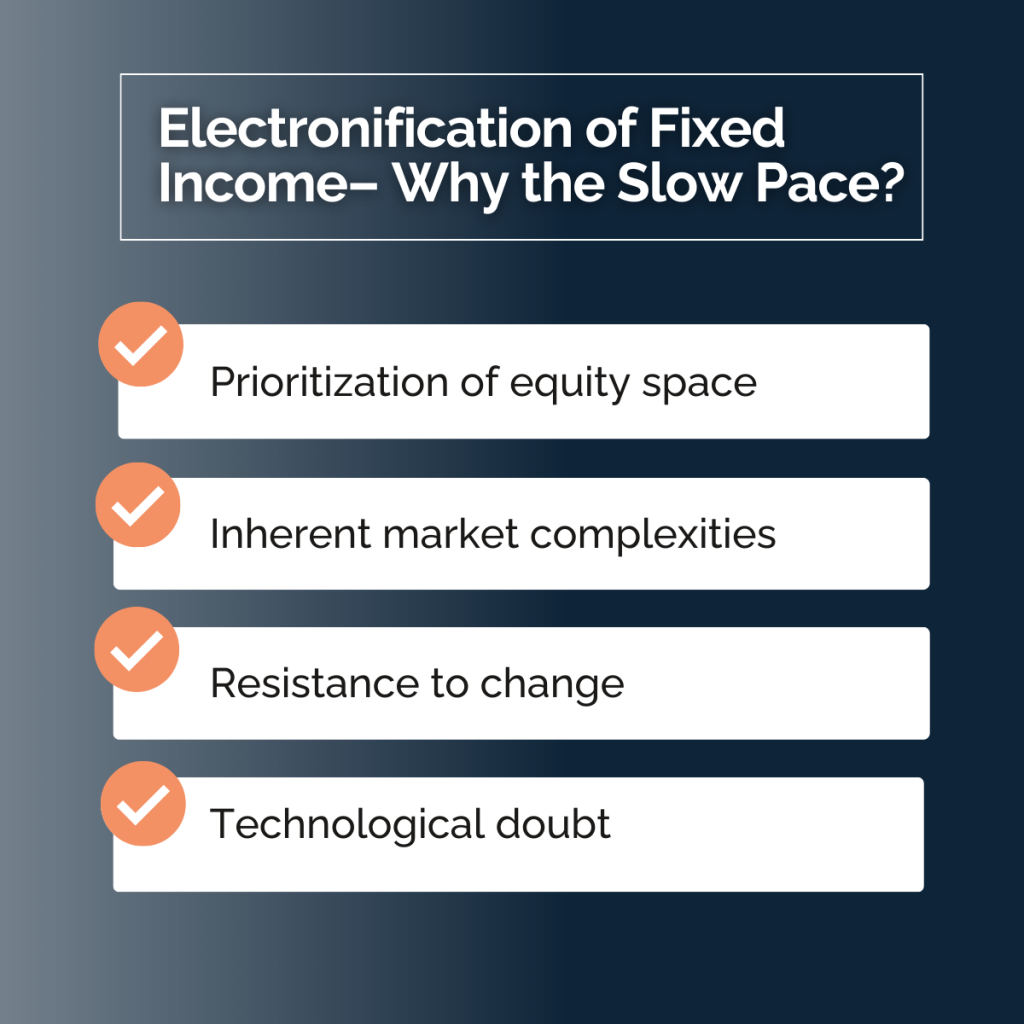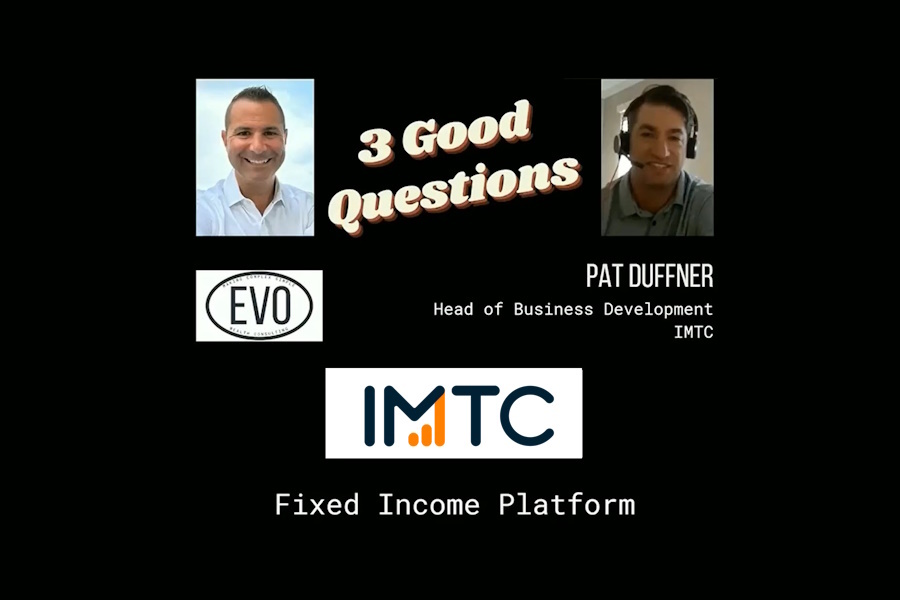MMI: The Electronification of Fixed Income

This quarter, we’re proud to publish a piece in MMI’s Journal of Investment Advisory Solutions. There’s little doubt that when it comes to technological innovation, fixed income portfolio managers must adapt or be left behind. In recent years, fixed income has begun to embrace electronification: leading to a dramatic improvement in efficiency, scalability, and customization.
Read below for a more detailed discussion on what market factors have spurred these changes, the benefits of electronification, and how fixed income portfolio managers can assess new technologies.
The Electronification of Fixed Income
Technology innovations designed for fixed income asset management have lagged the equity side of the business for decades. Only recently have fixed income solutions meaningfully boosted capabilities and workflow efficiency. Larger firms that adopted early versions of these technologies are either tethered to outdated platforms with a limited ability to improve customization and scalability, or are investing significant internal resources to develop their own technologies in an effort to keep pace.
Although the global bond market easily trumps the equity market in size, the slow pace of electronification in fixed income dramatically hampers efficiency, which hurts profitability. Many fixed income managers continue to spend too much time using inefficient manual processes, partly because that’s the way they have always done things and partly because they are not aware of the benefits newer technology platforms offer. However, over the last few years there has been a notable increase uptick in electronification in the fixed income industry. Here, we explore the factors driving this change.
Electronification in fixed income – why the slow pace?
First, why did the fast pace of technological innovation in asset management bypass the fixed income arena? In our view, these are the key reasons:
- Technology providers prioritized the equity space
Equity markets are more “exciting” than bond markets (that’s the conventional wisdom), and are likely to generate higher returns, on average. That allows equity managers to charge higher fees than are typical for most fixed income managers, so they can spend more on technology. As a result, technology and the capital to fund its development heavily favored the equity side of the business for decades. - Fixed income markets are complicated
The complexities of fixed income markets, including its decentralized structure, wide range of instruments, lack of reporting standards, enormous data requirements and limited data availability were difficult for earlier technology solutions to handle. It wasn’t until recently that developers had the tools needed to go beyond calculator functions (computing yields, durations, etc.) to process thousands of lines of code in seconds and deliver cloud-based solutions powerful enough to not only handle but improve fixed income workflows. - Resistance to change
Many fixed income managers still feel they must rely on their specialized knowledge, home-grown processes, and internal but fragmented tools (often spreadsheets) developed over decades to do their jobs effectively. While these siloed, manual processes often lead to sub-optimal decisions, cause costly mistakes, and create “key man” risk, there has been considerable resistance to changing the status quo. This has limited the adoption of fixed income technologies, which in turn has slowed the pace of development. - Doubts about technology’s ability to improve fixed income processes
Historically, the interoperability and connectivity taken for granted in the equity world did not exist in fixed income. For example, information about liquidity and pricing was scarce at best. A platform with a truly integrated workflow would, in theory, improve on this by integrating market data and inventories, trade execution and allocation, portfolio construction, optimization, compliance, and back-office ties. It just didn’t seem possible for technology to replicate and improve on what bond portfolio managers do manually.
Resistance to electronification in fixed income has persisted for a long time, but recently the mood has shifted. Technology has improved dramatically, reducing development time and improving accessibility and connectivity through cloud-hosting, APIs and other tools. As competitive pressures are always increasing, managers are looking for solutions that can improve their workflows and deliver customized strategies to clients while keeping costs low.

Customization, optimization, and client expectations drive adoption
Advancements in technology push innovators to leverage new tools to achieve efficiencies in every industry; fixed income is no exception. Other forces driving electronification in fixed income are specific to the industry, including:
- The rising demand for customization. Investors increasingly want customized portfolios, including the ability to align their investments with their values. The industry is responding, and customized fixed income strategies are now being offered by investment managers, home offices, and wealth managers.
- Interest in tax efficiencies. The interest in customization via separately managed accounts (SMAs) or direct indexing is often driven by tax efficiencies. This would be incredibly time-consuming if done manually, and would require increasing headcount and therefore costs. Technology can streamline this process, allowing firms to offer more customized solutions to more clients at a lower price point.
- Optimized solutions deliver customization. Technology now enables managers to truly optimize fixed income portfolios at scale, to achieve the full benefits of customization. More than a simple allocation tool, true optimization incorporates inputs from traders, analysts, and clients across groups of portfolios, producing viable outcomes using those various inputs, targets, and constraints.
- Clients expect technology. More fixed income managers are adopting new technologies to better serve millennial and Gen-Z clients who are comfortable managing their finances on mobile apps and online. These clients expect their managers to use technology—to them, manual and one-size-fits-all processes look cumbersome and outdated.
Fixed income electronification and the wealth management business
Clearly, electronification allows fixed income managers to offer customized solutions at a low cost. Fixed income technology solutions also help financial advisory firms/RIAs remain competitive.
Advisors must manage clients’ assets and attract new business, and there are only so many hours in a day. Some outsource the investment process; others have internal teams to manage portfolios while the advisor attracts new clients and supports existing relationships. Many now rely on a home office’s model portfolios and technology tools for tax-loss harvesting and optimization, allowing advisors to keep asset management in-house. Home offices want to offer more technology-driven solutions to help their advisors expand their client base efficiently: a win-win proposition.
Choosing fixed income technology
When choosing a fixed income technology platform, here are some key issues to consider:
Build vs. buy vs. partner – When choosing technology, firms typically face three choices: build, buy, or partner. Building is tempting because, in theory, it produces a tailor-made system. However, it often takes years longer than expected, and then it is a struggle to retain developers when there is not enough to keep them challenged. Buying a system is less risky. Although it may not offer the features of a home-grown solution, it can be a reasonable trade-off. However, a platform chosen today may not evolve with a firm’s need. Partnering combines the best of both approaches. A platform built by a tech-savvy firm with experienced developers can provide enhancements via a valuable partnership for years to come.
Native cloud technology – A well-designed native cloud-based platform can release new features seamlessly, helping to future-proof a firm’s processes (note: less cloud-savvy legacy vendors are often in maintenance mode, making them less motivated to release enhancements). Cloud technology offers other well-known benefits: it reduces the demand on IT infrastructure and resources, is easy to scale up or down, and offers top-of-the-line cybersecurity.
Optimization vs. allocation – The term “portfolio optimization” is often applied to what is really a “trade allocation” function. Both are useful, but they are not synonymous. A true optimizer requires a higher level of sophistication and can be a true differentiator in efficiently customizing portfolios.
Faced with competitive pressure and a technology-driven world, it’s no longer a question of if fixed income will move toward electronification, but rather how quickly. To be competitive, firms cannot afford outdated systems and workflows; they need to embrace what new fixed income platforms can deliver today.
.





